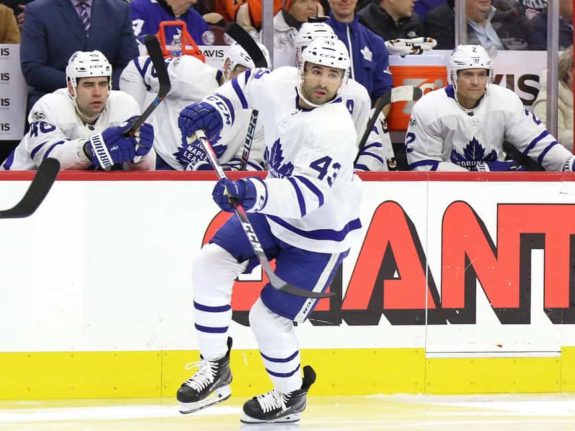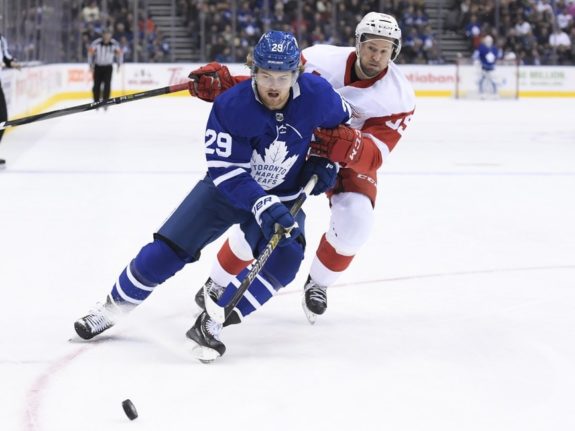For some, the simple fact that the Toronto Maple Leafs were able to sign William Nylander might be considered a success in itself. At one point near the end of November, it seemed more doubtful than anything that the young Swede would be suiting up for the team this season.
Enter a six-year and almost $10.3-million contract and the 22-year-old was back in North America donning the Maple Leafs’ blue and white. A success, right? Quite the contrary, in fact, as now Nylander will be expected to live up to the contract he signed.
What makes it more difficult is that the offensively-skilled Nylander only has two-thirds of a season left that will represent the first year of his newly-signed contract, which means even less time for him to showcase why he felt he needed to holdout for the contract he received.
So, with that in mind, what would qualify as a successful season for Nylander? Can he achieve it strictly on offensive merit alone or will he have to find a way to add a new element to his game – possibly something in the defensive end?
Nylander’s Growth Important to Maple Leafs
It was just five years ago that the Maple Leafs dealt with another holdout of sorts in Nazem Kadri. Coming off a 44-point season in his first full year – albeit a lockout shortened season – Kadri was set to sit out training camp in the hopes of getting a deal done with the Maple Leafs.

While CBC Sports reported that he was looking for a long-term deal along the lines of $5-million per year, Kadri was quoted as saying he was simply looking for something fair to get done.
At the time, Kadri was a mediocre offensive player with some upside when it came to his shot and ability to get under the skin of opposing players. Still, his 49.2 Corsi For Percentage over his first three seasons made it hard to judge just how good he was as an all around player.
He struggled defensively and the goal was to make him into a two-way player. With that, the Maple Leafs signed the forward to a two-year, $5.8-million contract with a cap hit of $2.9 million per season. It wasn’t what Kadri wanted exactly, but it bridged the young forward and forced him to prove what he could do.
Kadri has since turned into one of the more reliable depth centers in the Atlantic Division, pairing up against some of the best opposing players in the league. He’s notched two consecutive 32-goal seasons, including a 61-point career-high in 2016-17 – finishing among the top 20 in Selke Trophy voting.
His Corsi For has jumped to 51.0 CF% over the last three seasons and he’s shown the ability to shutdown players like Connor McDavid when called upon. The Maple Leafs rewarded his growth and development with a six-year deal in April 2016 worth $27 million – or $4.5 million per season.
Now, the team will likely expect some kind of change in the way Nylander plays the game. After all, while his back-to-back 61-point seasons are impressive, the team needs much more out of the young forward if they have any hope on capitalizing on their window for success.

Over the last three seasons, Kadri’s had more defensive zone starts than he has in the offensive zone, Nylander is the opposite. And while his numbers dictate a different story (51.4 CF% last season and 49.0 FF% last season) he does have some growing to do when it comes to his defensive zone coverage.
Even if he remains a 61-point player, if he can become a reliable two-way player the Maple Leafs would surely consider this signing a bigger success. That said, it wouldn’t hurt to see him increase his production on the offensive side of the puck either – especially ay $6.9 million per season.
A Success on the Offensive End
In a recent article, we looked at some comparable contracts to what Nylander was expected to sign. Now that it’s a done deal, his new contract is noticeably more than guys like David Pastrnak who’ve proven their worth on the offensive side of the puck.
Now, that’s not to say that he hasn’t done well offensively over his first two full seasons in the NHL. However, at nearly $7 million, you’d expect more from a highly-touted offensive player like Nylander than just 61 points.
So far over his career, he’s tallied 48 goals and 135 points in 187 regular season games for the Maple Leafs. That’s an average of 0.26 goals and 0.72 points per game over his career. As a 21-year-old last season, he played all 82 games and finished the year with 61 points. It was his second consecutive year with 20 goals and he added four points in seven playoff games.
Related: The Hockey Writers Podcast – Ep. 1: Nylander, Wilson, Fuhr One-on-One & More
Now, he’ll be playing in a self-shortened season with the opportunity to suit up for 54 regular season games. That’s if he can stay healthy for the remainder of the regular season.
With that in mind, what would a successful offensive season look like for the 22-year-old?

Well, assuming he can maintain his career numbers, he’d have to average 0.72 points over the remaining games. However, he’s been held pointless in his first two contests of the season. So, here’s how it breaks down. To average 0.72 points per game in 54 games, Nylander would have to record 39 points. With only 52 games left though he’ll have to average 0.75 points per game.
Surely the Maple Leafs would love to see a step up in the point-per-game department considering the money they have invested in Nylander. And while he likely won’t be reaching the 61-point plateau for a third consecutive season, a jump to 0.8 points-per-game or 43 points could should the organization that they made the right decision in locking Nylander up long-term.